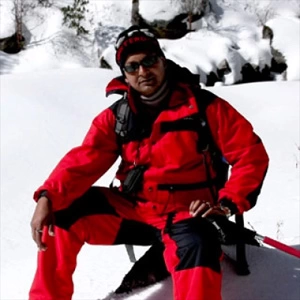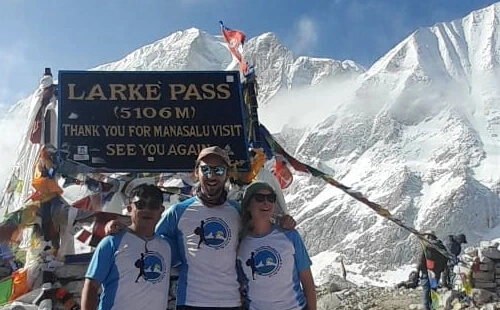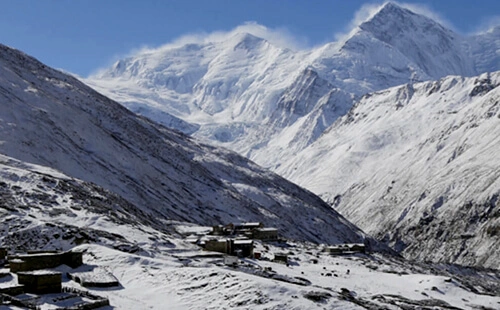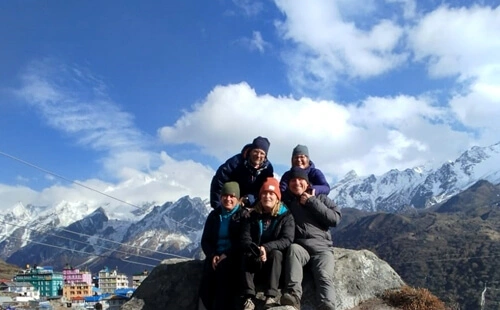Autumn in Langtang Valley
Autumn in Nepal is a highly anticipated and gorgeous season that offers pleasant weather, clear skies, and stunning natural charm. Hence, the months of September, October, and November are considered some of the best times to visit the country as well as to trek the Langtang Valley.
This is the most popular time to trek in the Langtang Valley due to the very obvious reasons: crystal blue skies, excellent visibility, stable weather, comfortable hikes in moderate temperatures, and well-defined trekking trails.
Here are some primary features of the autumn season that make it the best time to trek the Langtang Valley:
Weather expectation in Autumn at Langtang
Autumn in Nepal typically spans from September to November, just when the monsoon rains have subsided, resulting in dry and steady weather conditions. The temperature during the day is mild and pleasing, ranging from 20 degrees Celsius to 25 degrees Celsius (68°F to 77°F) in most parts of the country.
Although the night gets colder at the higher elevation with a sudden drop in the temperature to around 5°C to 10°C (41°F to 50°F), it is a fantastic time to trek in the Langtang Valley, characterized by unclouded skies, abundant sunshine, and lush landscapes.
Spectacular Natural Beauty in the Langtang Valley
The meadows and trees come alive during the autumn in the Langtang Valley, with verdant hills vibrant with blooming rhododendron forests as an outcome of the monsoon rain. The whole Langtang region at this time burst into colorful blooms of rhododendrons, adding splashes of red, white, and pink to the scenery.
Vigorously flowing rivers and waterfalls in the autumn create soothing soundscapes that match the rhythm of your heartbeats, inviting you to get lost in their serenity.
Heavenly Mountain Views in Autumn
Autumn is also renowned among trekkers and mountaineers for its extraordinary visibility in the Himalayan region. During the trek to Langtang Valley, travelers ought to be spellbound by the awe-inspiring panoramas of the snow-capped Langtang ranges against blue skies.
Festivals and Culture-encounters in Langtang
The autumn coincides with several main Nepali festivals, such as Dashain and Tihar, the largest Hindu festivals celebrated in Nepal when Nepali families come together to celebrate, perform various rituals, and exchange blessings.
If you trek the Langtang Valley in the autumn, you will get to observe the rich cultural heritage of Nepal and might also get to be part of these festivals.
Adventure Activities in Spring
Besides trekking, autumn is the most convenient time to perform different spine-tingling activities such as rafting, paragliding, and wildlife safaris in Nepal’s national parks, along with untamed life-watching in Langtang National Park.
No wonder it is the peak tourist season, attracting visitors from all over the world when the bustling tourist areas of Kathmandu, Pokhara, and other major cities are filled with travelers, creating a lively moment with each step you take.
Overall, autumn in the Langtang Valley is a magical season when it is at its most inviting phase due to the combination of amusing weather, stunning vistas, cultural fusion, and the opportunity to witness the majestic Langtang Lirung.
Trekking Langtang Valley in Spring
Spring is yet another beautiful and dynamic season to trek the Langtang Valley, featuring freshly blooming wildflowers, lush greenery, mild temperatures, and various cultural celebrations.
The months from March to May following the winter preceding the monsoon season are regarded as one of the ideal times to set out for trekking in the Langtang region, and here’s why:
What is the weather like in Langtang Valley in Spring?
Spring is generally mild and pleasing in the Langtang Valley, while the daytime temperature may vary relative to the elevation and location, from 20°C to 30°C (68°F to 86°F) in the lowlands to 10°C to 20°C (50°F to 68°F) in the higher altitude.
The nights are cooler precisely at the highlands, but not that extremely cold.
Natural Fascination in Langtang Valley
Spring brings an explosion of colors to the landscapes of the Langtang region. The valleys and hills are camouflaged in newly flourishing rhododendron forests with a dazzling display of pink, red, and white flowers.
Waterfalls and rivers flow at full speed due to the melting of snow from the Himalayas, forging a heavenly ambiance, while greenery in the terraced fields adds more to the picturesque scenery.
Cultural savor in Langtang Valley Trek
The spring season sees numerous important cultural and traditional festivals, such as Holi (the festival of colors) and Nepal Sambat (the Nepali New Year). The Holi is observed with greater enthusiasm with colored powders and water, which symbolizes the triumph of good over evil.
The Nepali New Year is also marked by various cultural events and celebrations called Jatra.
See Radiant Mountains in Spring
Spring is an unrivaled time to watch the ravishing mountain views of Dorje Lakpa (6,966 m), Langtang Lirung (7,245 m), and Mt. Gaurishankar (7,134 m) in the Langtang National Park.
The views are often unobstructed and shine brightly enough to blind the eyes, which makes it an exquisite time for mountain aspirants in the transparent skies and stable weather.
To sum it up, spring is a time of renewal and celebration, and additionally, the calm weather, blooming hills, and cultural festivities create an outstanding opportunity to explore the natural wonders of the Langtang Valley and are noted as a highly desirable season to trek and travel.
Langtang Valley Trek in the Winter
The winter season in Nepal spans from December to February; it is usually chilly in the upper Himalayas. So, it is also considered the offseason for trekking in the Langtang region.
Despite that, it offers unique Himalayan views like never before and has its own exclusive set of pros and cons. They are discussed as follows:
Why Langtang is Fewly-Crowded in Winter?
Trekking Langtang in the winter season is a classy choice for trekkers preferring solitude and a quieter trail, as at this time the trekking routes are less crowded.
More impressive, clear mountain views in Langatang’s winter
The skies in winter in the Valleys of Langtang are usually clear, offering first-class snow-clad peaks and surrounding landscapes. The mountains at this time look more remarkable than in any other season.
Rare natural beauty in the winter of Langtang
The landscapes fully covered with snow and frozen waterfalls create a different kind of magical beauty in the winter in the Langtang region that is hardly left unnoticed, even from the city of Kathmandu, afar from the Himalayas.
Why are Langtang trails budget-friendly in winter?
Since it is kind of the offseason, you might find accommodations, food, and other services lower in price along the route in winter at the Langtang Valley Trek. So, trekking Langtang in winter is perfect for budget-conscious trekkers from all around the globe.
Temperature in winter at Langtang Valley
Even though the daytime temperatures in winter in the Langtang Valley might be bearable, the temperatures at night can drop to below zero and go negative. At the higher altitudes, you can expect extreme frost. Therefore, at this time, it is necessary to have adequate cold-weather clothing.
Why Limited Tea Houses in Langtang Valley?
In the winter, many tea houses and local lodges along the Langtang Valley trekking routes might be closed as a result of low tourist traffic. It is crucial to do essential advance checking and plan your itinerary accordingly before setting out for an actual trek.
Do shorter trekking days in winter cause trouble trekking in Langtang?
As we already know, the days are shorter in winter, giving you less daylight for trekking. Meanwhile, if you plan your daily trekking schedule accordingly and start early in the morning, you will make it through the journey without much of a problem.
Possibility of snowfall in Langtang trek
Without a single thought, it is true that in the winter season, it snows heavily. Depending on the snowfall, the trek in the Langtang Valley can be more challenging and potentially hazardous when covered with snow and ice.
Proper gearing, including crampons or microspikes, might be necessary.
Why Less flora and fauna in the Winter of Langtang?
Due to the cold, the lush woods and rhododendrons by this time lose their leaves and petals, and in the absence of them, you are likely to miss out on the vibrant colors of spring and autumn.
For experienced trekkers and when prepared well for the cold weather and probable risks, trekking in Langtang Valley in winter can be a phenomenal and gratifying adventure. It is advisable to travel with a local guide who has gained close insight into the local terrain and conditions. Additionally, make sure to keep up-to-date with information about weather and trail status before setting out on your trek.
Trekking Langtang Valley in Summer
Summer in Nepal falls between June and August. While it is an attractive time to visit the Langtang Valley due to abundant greenery and warmer temperatures, it comes with weather-related advantages and challenges. Here is what you can expect during the summer season in the Langtang region:
Flourishing weeds in summer
The summer season brings heavy rainfall to Nepal, so it is also known as the monsoon season, leading to lush, vibrant, and green landscapes along the trekking trails. The valleys and hills are mostly hidden in dense vegetation, and the forests are lively, making the landscapes exceptionally picturesque.
Solitary Langtang Trail in Summer
The monsoon is noted as the off-season, particularly for trekking in Langtang with fewer fellow tourists. That is why it is a quieter and more peaceful trekking experience in the region during the summer.
Lower prices during the trek
As a trekking off-season, you will find low charges for accommodation and services along the Langtang Valley Trek route in the summer, making it more affordable for you due to decreased demand.
Can you trek to Langtang in Rainfall?
Monsoons in Nepal mean heavy and persistent rainfall. Continuous rainfall leads to slippery and muddy trekking trails, landslides, and flooding in the Langtang Valley, primarily in lower-lying areas.
So, rain gear, waterproof boots, and gaiters are essential trekking equipment to trek the Langtang Valley in the summer.
Landslides and avalanches in summer?
The highlands of the Langtang trekking route are prone to landslides and avalanches during the summer due to excessive rainfall. It is important to stay updated on the conditions of the trail and consider the inherent route changes while on the way to the Langtang Valley.
Why Difficult Transportation in Summer in Nepal?
Usually, the monsoon rains in Nepal lead to road and trail washouts, causing transportation delays and disruptions common to and from the starting point of the trek.
You have to be prepared for potential travel challenges in the summer to trek Langtang.
Are there Leaches and insects in the summer of Langtang Valley?
The wet conditions of the trail in the monsoon season can lead to an increase in leeches and insects along the trekking routes and forests along the way. It is essential to take precautions by wearing leech socks and using insect repellent.
Visiting Langtang Valley in the summer season can be thrilling and something new to add to your memory when prepared accordingly for the rainy weather, considering the impact of the monsoon on the trail. It is recommended to trek with a local guide and appropriate gear, including rain gear and insect repellent; check weather forecasts regularly; and be flexible with your itinerary.
Ultimately, your preferences for weather, scenery, and trail conditions determine the best time to trek in the Langtang Valley. Yet, it is good to know that autumn and spring maximize their chances of experiencing the true beauty of the mountains and comfortable trekking situations.
By now, you must have selected your time to trek in the Langtang Valley and might be wondering how long it will take you to get there, which is discussed as follows in brief:
How far is Langtang from Kathmandu?
The distance of Langtang from Kathmandu varies depending on your starting point, while the Syabrubesi remains a common gateway to trek the Langtang region, which involves a road journey by bus or private jeep.
Syabrubesi is approximately 117 kilometers (73 miles) away from Kathmandu and is 7 to 9 hours by road, depending on the condition of the road, traffic, and the mode of the vehicles, following a scenic route through mountainous terrain and passing several towns and villages.
On the other hand, the duration of the Langtang Valley trek is determined by your trekking pace, itinerary, and days separated for acclimatization, which on average is 7 to 10 days.
Thus, Langtang Valley is one of Nepal's most beloved off-the-beaten-short trekking destinations, known for its sky-preaching hills and mountains. The best time to trek the Langtang Valley is no doubt the post-monsoon autumn and pre-monsoon spring, with the finest weather conditions, a blue sky, and the best trekking experience overall. The rest of the other seasons, with their distinctive appeals, are also trackable when geared appropriately.




